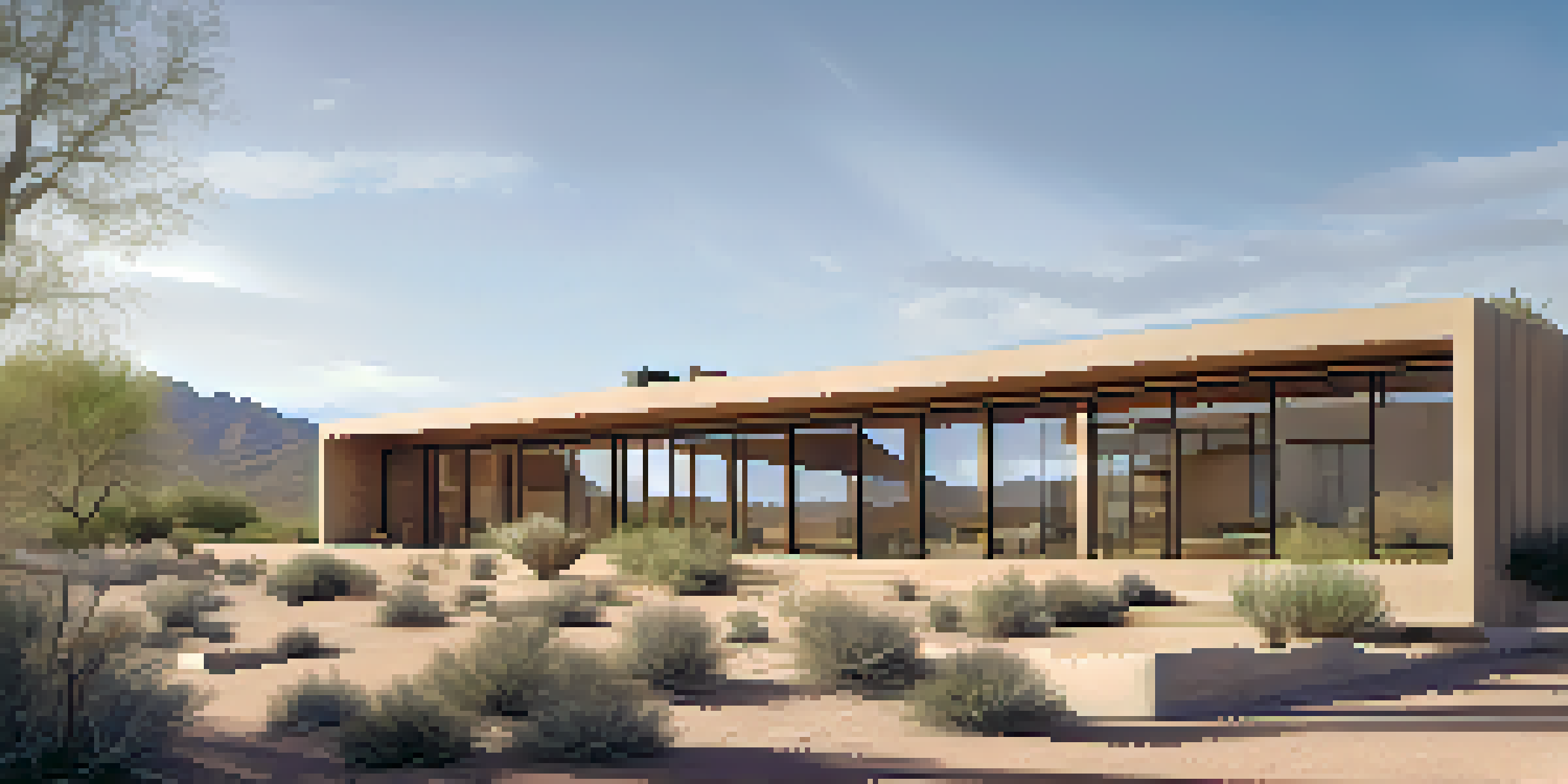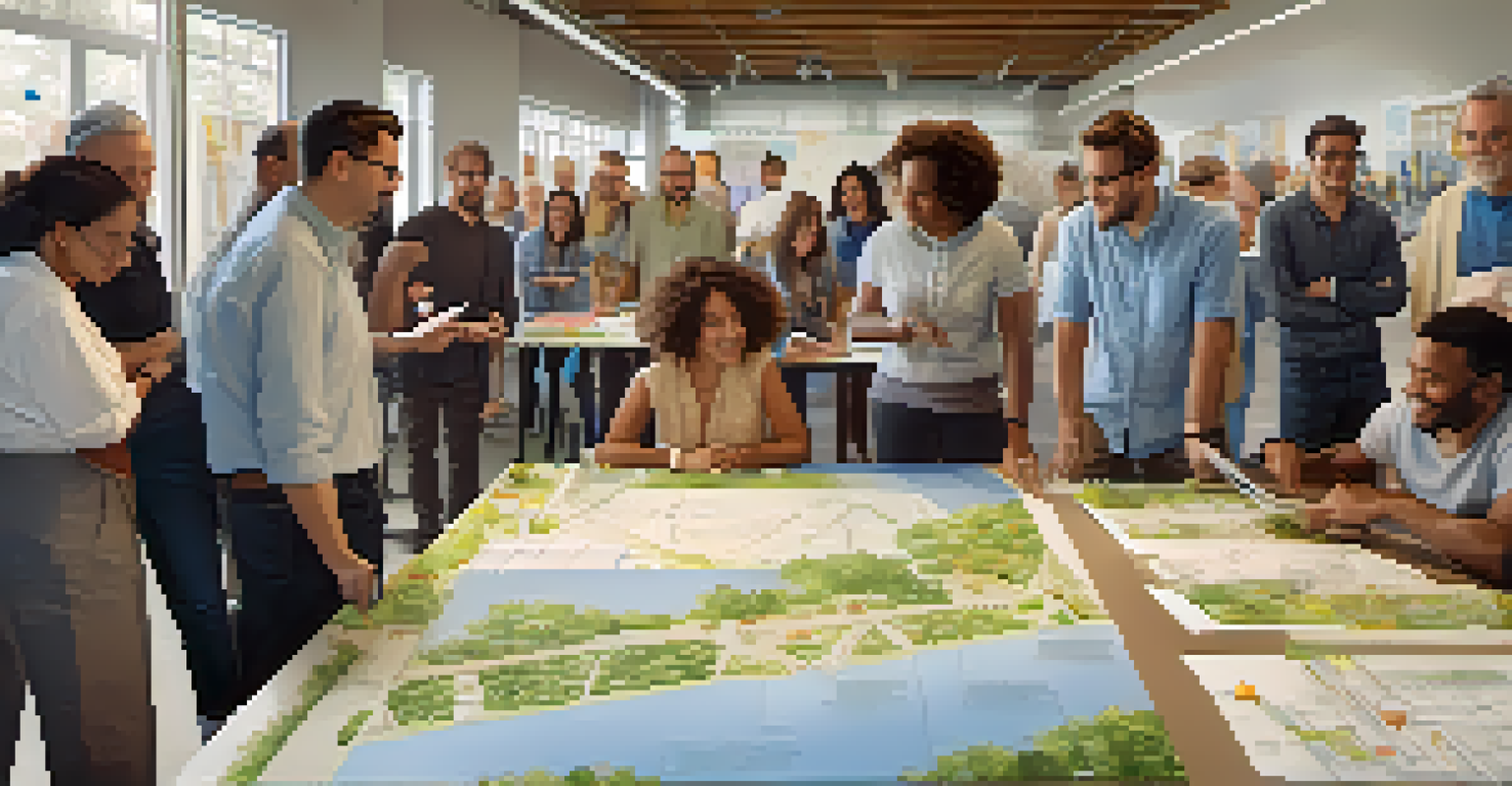Community Engagement in Sustainable Architecture in Tucson

Understanding Sustainable Architecture in Tucson
Sustainable architecture focuses on minimizing the environmental impact of buildings. In Tucson, this means designing structures that harmonize with the desert landscape while maximizing energy efficiency. The unique climate of the Southwest presents distinct challenges and opportunities for architects in the area, making sustainable practices not just beneficial but necessary.
Sustainable architecture is about creating buildings that are in harmony with the environment, using resources wisely and efficiently.
By incorporating local materials and energy-efficient technologies, architects can create buildings that not only conserve resources but also celebrate the rich cultural heritage of Tucson. For instance, using adobe and other locally sourced materials not only enhances the aesthetic but also reduces transportation emissions. This connection to place is vital in fostering a sense of identity within the community.
Moreover, sustainable architecture in Tucson often emphasizes passive design strategies, such as natural ventilation and thermal mass. These techniques help maintain comfortable indoor temperatures without relying heavily on mechanical systems, making buildings more resilient to climate variations. As residents engage with these concepts, they can better appreciate the long-term benefits of sustainable living.
The Role of Community Engagement in Architecture
Community engagement is essential in creating architecture that truly reflects the needs and desires of local residents. In Tucson, this involvement can take many forms, from public workshops to focus groups, allowing individuals to voice their ideas and concerns. When architects prioritize community input, they create more functional and appealing designs that resonate with the people who will inhabit these spaces.

Engaging the community also helps to build trust and foster collaboration between architects and residents. When people feel their opinions are valued, they are more likely to support projects and participate in their implementation. This collaborative spirit can lead to innovative solutions that might not emerge from traditional design processes alone.
Sustainable Design in Tucson
Architects in Tucson prioritize sustainable architecture by harmonizing buildings with the desert landscape and utilizing local materials.
Additionally, involving the community can highlight local issues that architects might overlook. For instance, feedback from residents can reveal specific environmental concerns or cultural elements that should be integrated into the design. This kind of insight is invaluable for creating architecture that is not only sustainable but also socially relevant.
Case Studies of Successful Community Engagement
Several projects in Tucson exemplify the power of community engagement in sustainable architecture. One notable example is the development of the Mercado District, a mixed-use space that integrates residential, commercial, and public areas. Through extensive community consultations, designers were able to create a vibrant hub that reflects local culture while promoting sustainability.
Community engagement is not just about gathering input; it's about creating a dialogue that values every voice in the design process.
Another inspiring case is the design of the Tucson Community Gardens, which transformed underutilized land into green spaces for urban agriculture. Residents played a crucial role in shaping the layout and functions of these gardens, ensuring they met local needs. This project not only promotes sustainable practices but also strengthens community bonds through shared gardening experiences.
These case studies demonstrate that when communities are actively involved in the design process, the resulting architecture is not only more sustainable but also more meaningful. By listening to the voices of local residents, architects can craft spaces that foster connection, resilience, and pride.
The Importance of Education in Sustainable Practices
Education plays a pivotal role in fostering community engagement in sustainable architecture. Programs targeted at schools and local organizations can raise awareness about the benefits of sustainable design and construction. By educating residents about sustainable practices, communities become more invested in advocating for environmentally friendly projects.
Workshops and seminars can provide practical knowledge on topics such as energy efficiency, water conservation, and the use of sustainable materials. When community members understand these concepts, they can better participate in discussions about new developments and advocate for sustainable solutions. This grassroots movement can lead to a greater demand for environmentally responsible architecture.
Community Voices Matter
Engaging the community in architectural processes ensures that designs reflect local needs and foster a sense of belonging.
Additionally, educational initiatives can inspire future generations of architects and builders. By instilling a sense of responsibility towards the environment, these programs can cultivate a workforce that prioritizes sustainability in their designs. Ultimately, education serves as a foundation for a more engaged and environmentally conscious community.
Challenges of Community Engagement in Architecture
While community engagement is crucial, it is not without its challenges. One significant hurdle is ensuring that all voices are heard, particularly those from marginalized groups. In Tucson, it’s essential to create inclusive platforms that allow everyone to contribute their perspectives and needs, ensuring equitable representation in architectural discussions.
Another challenge is balancing community desires with practical constraints such as budget and zoning regulations. Sometimes, what the community envisions may not align with what is feasible, leading to frustration on both sides. Architects must navigate these conversations delicately, finding ways to incorporate community input while adhering to necessary guidelines.
Moreover, engaging the community often requires time and resources, which can be limited in many projects. This can lead to rushed processes that overlook meaningful engagement. To overcome this, project leaders should prioritize community involvement from the outset, allocating sufficient time to build relationships and cultivate trust.
Future Trends in Community Engagement and Architecture
Looking ahead, the integration of technology in community engagement is set to revolutionize how architects interact with residents. Tools like virtual reality and interactive online platforms can facilitate broader participation, allowing individuals to visualize proposed designs and provide feedback from the comfort of their homes. This accessibility can lead to more comprehensive engagement efforts.
Additionally, the push for equity in architecture is gaining momentum, with a focus on ensuring that all community members have access to sustainable and affordable housing. As awareness grows, architects are increasingly incorporating social equity into their designs, ensuring that sustainability is not just a privilege for some but a right for all.
Education Drives Sustainability
Educational initiatives empower residents to advocate for sustainable practices, creating a more environmentally conscious community.
Finally, the emphasis on resilience in architecture is likely to shape future community engagements. As climate change continues to present challenges, communities will need to collaborate on solutions that prioritize sustainability and adaptability. By working together, residents and architects can create spaces that are not only beautiful but are also prepared for the uncertainties of the future.
Conclusion: Building a Sustainable Future Together
In conclusion, community engagement is a cornerstone of sustainable architecture in Tucson. By fostering collaboration between architects and residents, we can create spaces that truly reflect the needs and values of the community. This partnership not only leads to more sustainable designs but also strengthens the social fabric of Tucson.
As we look to the future, it's clear that the journey toward sustainability is one that requires collective effort. Whether through educational initiatives, case studies, or innovative technologies, there are countless opportunities for engagement. Each voice matters, and when combined, they can create a powerful impact.

Ultimately, building a sustainable future is a shared responsibility. By embracing community engagement in architecture, we can ensure that Tucson thrives as a vibrant, resilient, and environmentally friendly place for generations to come.